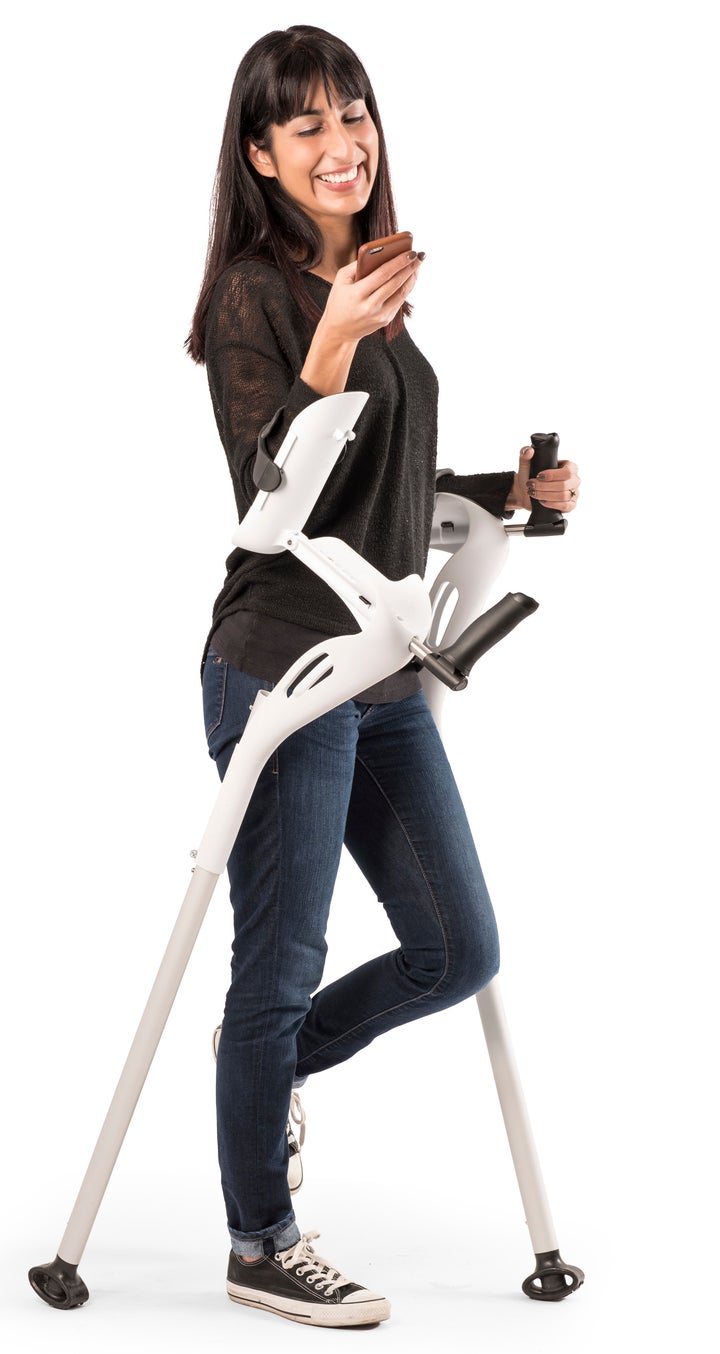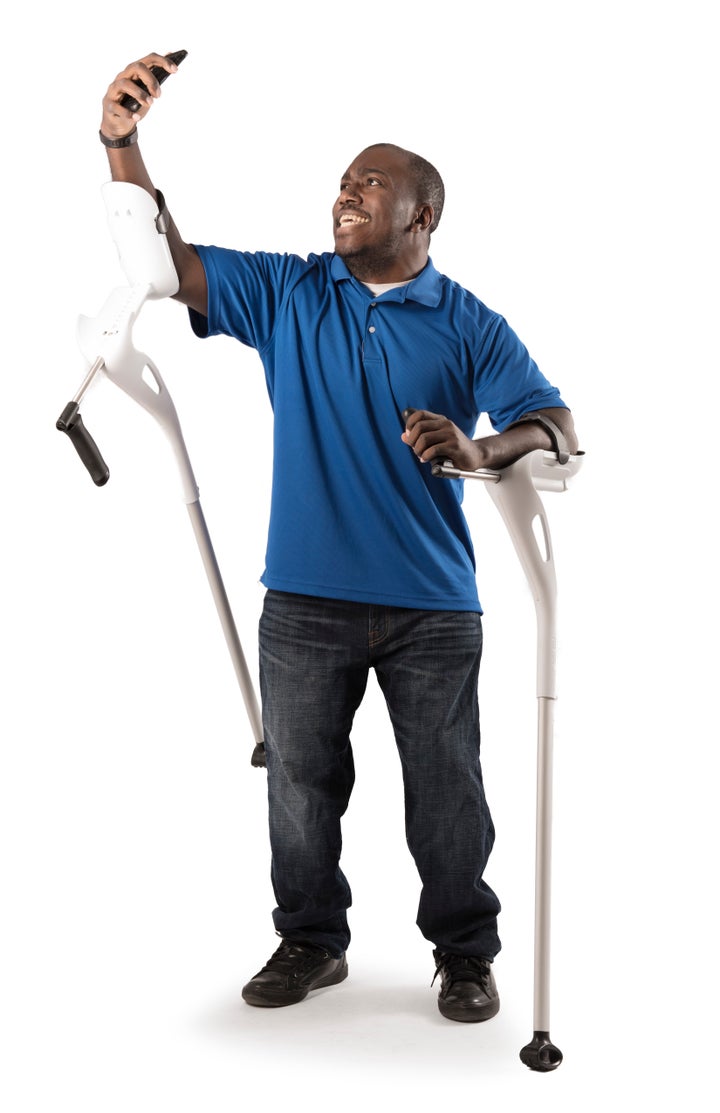Recently, with help from Doctor of Physical Therapy Lauren Jarmusz, I interviewed Max Younger, Co-Founder of Mobility Designed. Mobility Designed has been featured in Tech Insider and numerous media outlets. Max is an Industrial and Interaction Designer that holds multiple patents for his designs. He has experience working for Hallmark Cards and Dimensional Innovations. Max believes that mobility should be as pain free as possible and is redefining mobility with his invention, the M+D Crutch which supports the user’s weight with their elbows instead of their armpits. See our interview here:
Marquis Cabrera: What is Mobility Designed? Where did you get the idea from?
Max Younger: Mobility Designed (www.mobilitydesigned.com) is a company focused on creating and delivering Personal Assistive Devices that redefine mobility. We combine design and function to address the pain in the armpits, hands, wrists and shoulders that can be caused by traditional crutches.
The inspiration came from watching my dad, on and off crutches most of my childhood. He used them for various knee injuries/surgeries, and 6 knee replacements. In 2008, he became an above the knee amputee. This solidified my need to really solve this crutch problem. My dad is not one to complain about things but I knew it was a problem and he had damage to nerves in his hands and his wrists. My wife, Liliana, and I knew the armpit was off limits as it is not meant to support weight. We started working on it and came up with hundreds and hundreds of ideas...most of which didn’t work for various reasons. We built many prototypes, and came up with a better solution, the M+D Crutch.
Marquis Cabrera: What pain point are you solving?
Max Younger: Anyone who has used traditional crutches knows how painful they are. They cause pain in the armpits and forearm crutches can cause pain in the wrists, hands and shoulders with extended use. The M+D Crutch evenly distributes the user’s weight from the elbow through the forearm, eliminating pressure on those pain points.
Short-term users have a more comfortable experience during their time on crutches. The M+D Crutch offers an alternative for long-term crutch users. People that haven’t been able to use alternatives because of pain or damage to their hands or wrists and have been relegated to using a wheelchair as their only solution have been able to use the M+D Crutch. While each person’s situation is unique, we have heard many amazing stories from our users.
Marquis Cabrera: What is the difference between the M+D Crutch and Loftstrand Crutches in Europe?
Max Younger: The Lofstrand crutch (or forearm crutch) supports the user’s weight primarily on the wrists. Many long-term users report pain and nerve damage after years of using these types of crutches. Alternatively, The M+D Crutch, supports the user’s weight by evenly distributing it throughout the elbow and forearm.
Marquis Cabrera: What is your core product?
Max Younger: The M+D Crutch is a patent pending crutch that not only supports the user’s weight differently, it offers many other features and benefits that are unlike anything on the market.
The M+D Crutch supports the user’s weight by evenly distributing it throughout the elbow and forearm. The cradle unlocks, allowing users to reach for things without having to remove the crutch. It has a rotating handle that allows users to hold or carry things without taking off the crutches. Flexible armbands provide support while making it easy to get the crutch on and off quickly. The patent pending feet grip the Earth, absorbing some of the shock from the ground that can be easily be switched out for different terrains. Finally, the M+D Crutch is adjustable in both arm length and height from 4’11” to 6’8” to provide a customized fit for each user.
Marquis Cabrera: How is tech infused?
Max Younger: The M+D Crutch was designed by studying how people move and utilizing the natural resources the body has, we came up with the solution of using the elbows and forearms to support user’s weight instead of traditional armpits. This was a paradigm shift for the crutch world. Everything else in the market utilized the axillary region (armpits), hands or wrists.
The body of the crutch is designed and engineered to give a little with each step, while the cradle that holds the arm can click in and out to allow the user to do normal everyday tasks like brushing their teeth without taking off the crutches. The main body utilizes light weight composite materials, and the vulcanized rubber feet grip the earth with loads of traction, engineered to flow with the user as they move.

Marquis Cabrera: How did you take it from a product to a business?
Max Younger: Early last year, the M+D Crutch went viral with over 50 million views worldwide. Eight months before product was even produced, it was sold out. The first few rounds of product have sold out by selling directly to consumers at www.mobilitydesigned.com. Our production has increased and we recently caught up with orders and have inventory in stock.
While we have had a lot of success selling direct to consumer online, we know that a lot of people would like to try the crutches before buying them. We are in the process of launching a national network of retailers that we anticipate driving a lot of traffic to.
Marquis Cabrera: What’s the size of the market is Mobility Designed going after?
Max Younger: The Global Personal Mobility Device space is estimated to be $12.7 Billion.
The US Crutch Market is a $320 million-dollar market with 10 million pairs of crutches sold annually. The M+D Crutch is currently shipping in the US, Canada and Mexico. We are working through regulatory requirements in other countries and expect to be able to ship to additional countries later this year.
Marquis Cabrera: Do you have a use case?
Max Younger: We conducted numerous rounds of research with actual users throughout product development including ethnographic and contextual research where users utilized the M+D Crutch for set periods of time in their home and work environments. Their feedback informed our product development and helped ensure that we are delivering a product that meets the needs of users with a variety of conditions.
Marquis Cabrera: Did you collaborate with any physical therapists on the build of the product?
Max Younger: We collaborated with both Physical and Occupational Therapists throughout the product development process. Their feedback has been helpful and we have been excited about their enthusiasm surrounding the M+D Crutch. They understand the pain points that we are trying to solve because they work with users who experience them every day.
Marquis Cabrera: Any “cool” products on the future roadmap?
Max Younger: While the M+D Crutch is our first product, we have a portfolio of new products in our pipeline that we will be launching in the next few years. We truly want to redefine mobility. There are a lot of opportunities to innovate in this space.
Marquis Cabrera: What advice would you give to someone looking to create “biotech-like” innovations?
Max Younger: Start by finding a clear problem to solve, go out, watch people and users in context to see for yourself. Be patient! It has taken us many years to get here. It is a regulated industry and it isn’t as easy as just launching a regular consumer product. Build a great team that has strengths where you lack. Build your ideas, test, and take your learnings to make something great!
